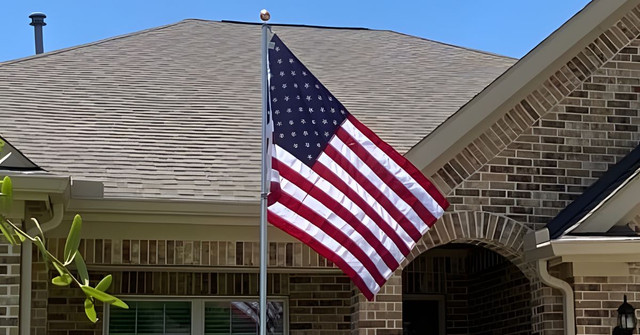Weather’s Impact on Outdoor Flag Longevity: Maintenance Tips
Jul 29th 2025
A flying flag is a statement, an emblem of pride, and a silent storyteller of history or belonging. However, the elements are relentless. Sunlight fades a flag’s vibrant colors, storms tug at its seams, and moisture weakens its fabric. Understanding the weather’s impact on outdoor flag longevity and knowing maintenance tips is the key to ensuring those cherished symbols keep soaring.
This guide explains how various weather conditions impact your flag and provides practical advice to help it withstand the test of time. From selecting the most durable materials to following simple care routines, these tips make it easy to protect your flag’s integrity while preserving its significance.
The Role of Weather in Flag Wear and Tear
Sun Exposure and UV Damage
Intense sun exposure can cause fading and weaken the flag fibers. Over time, UV rays break down the fabric, causing it to fray and lose its vibrant colors. The darker and more vibrant the color, such as navy blue, the more the fabric will be susceptible to fading. Selecting materials designed to resist UV damage is essential if your flag is exposed to sunlight for most of the day.
Wind Damage
Strong winds are some of the most damaging elements for outdoor flags. Constant flapping can strain the flag’s fabric and stitching, resulting in frayed edges and tears. To extend your flag’s lifespan in windy conditions, consider selecting durable fabrics designed for high-wind areas and attaching the flag securely to the pole.
Rain and Moisture
Rain-soaked flags are prone to mildew growth, which weakens the fabric and creates unsightly stains. Persistent exposure to moisture also accelerates wear on less durable materials. Flags made of synthetic fabrics, such as nylon or polyester, are ideal for wet conditions, as they shed water more effectively than cotton. Fortunately, regular drying can prevent moisture-related issues.
Snow and Ice
Winter weather presents unique challenges. Snow and ice can weigh down flags, deforming their fabric and causing tears. Additionally, moisture that freezes within the fibers can lead to stiffness and brittleness, especially for poorly suited materials. Switching to a smaller flag in snowy regions during winter months can reduce strain from ice accumulation.

Choose the Right Flag for Your Climate
Picking the right flag for your region’s typical weather can increase its longevity. Material and placement are critical considerations.
Material Matters
Not all flags are created equal. Knowing the best material for your climate can make all the difference in your flag’s longevity:
- Polyester offers unmatched durability and works well in areas prone to extreme weather conditions, such as strong winds or heavy rain.
- Nylon is lightweight, dries quickly, and is ideal for moderate climates.
- Cotton is best for occasional use in mild weather due to its vulnerability to moisture and wear.
Size and Placement
Large flags endure greater strain from wind and their own weight, which may shorten their lifespan. Similarly, placement plays an important role. Avoid hanging your flag where it will snag on branches, fences, or walls, and install poles away from structures and trees.
Maintenance Tips To Extend Flag Longevity
Flag care and maintenance can extend its lifespan, regardless of the weather it faces.
Regular Cleaning
Dirty flags are unsightly, and accumulated grime and pollutants can deteriorate the fabric. Regularly hand wash your flag with mild detergent and lukewarm water. Avoid using harsh chemicals or putting the flag in a washing machine, as this can weaken stitching and fabric.
Inspect for Damage
Frequently examine your flag for tears, fraying, or fading. Addressing minor issues early, such as resewing frayed edges, can prevent more damage down the line. Periodic inspections are especially important after extreme weather events.
Rotate Your Flags
If you display flags year-round, consider rotating multiple of the same flag. This keeps your displays fresh, and reduces constant exposure for one flag.
Proper Storage
Store flags not in use properly to prevent wear. Clean and dry the flag before folding it neatly and placing it in a moisture-free storage container. Avoid storing it in areas prone to extreme temperatures or humidity.

Seasonal Care Tips
Different seasons require varied care approaches for your outdoor flags. Adjust your maintenance and display habits to the conditions.
Spring and Summer: Protecting Against Sun and Storms
The warm seasons bring strong sunlight and rain. Choose nylon flags, and apply UV-protection sprays to maintain color vibrancy. Also, inspect the flag frequently for fading or mildew growth.
Fall: Preparing for the Changing Seasons
With falling leaves and moderate winds, fall is an ideal time to prioritize cleaning and remove debris or leaf stains. Ensure the flagpole is sturdy enough to withstand sudden seasonal storms.
Winter: Battling the Cold and Harsh Elements
Winter is the harshest season for flags, so save your large flags for better weather! Fly a relatively small flag during this season to minimize wear and tear. Frequent drying and storage during extreme conditions can preserve your primary flag.
When To Retire Your Flag
Knowing when to retire a flag is just as important as maintaining it. When a flag becomes too faded, torn, or frayed to be displayed respectfully, it’s time to replace it. Retire US flags in accordance with the flag code. Consider looking into local organizations or events that host flag retirement ceremonies to dispose of the flag.
Invest in Quality Flags From Independence Bunting
When purchasing American flags and bunting, choosing a reliable provider is essential for quality and durability. Independence Bunting offers several advantages that make it the ideal choice for your flag needs:
- Durable, high-quality materials designed to withstand outdoor elements
- Wide variety of sizes, styles, and designs to suit any occasion or requirement
- Expert craftsmanship that results in vibrant colors and sturdy construction
- Exceptional customer service and support for a seamless purchasing experience
Outdoor flags endure a lot from the elements, but with regular care, they can remain a source of pride and beauty. By understanding the weather’s impact on outdoor flag longevity and following seasonal maintenance tips, every step you take protects your flag’s integrity.
Treat your flag with the respect it deserves, and honor your values every time you hoist it. If you’re looking for a new flag to display, Independence Bunting is exactly what you need!








